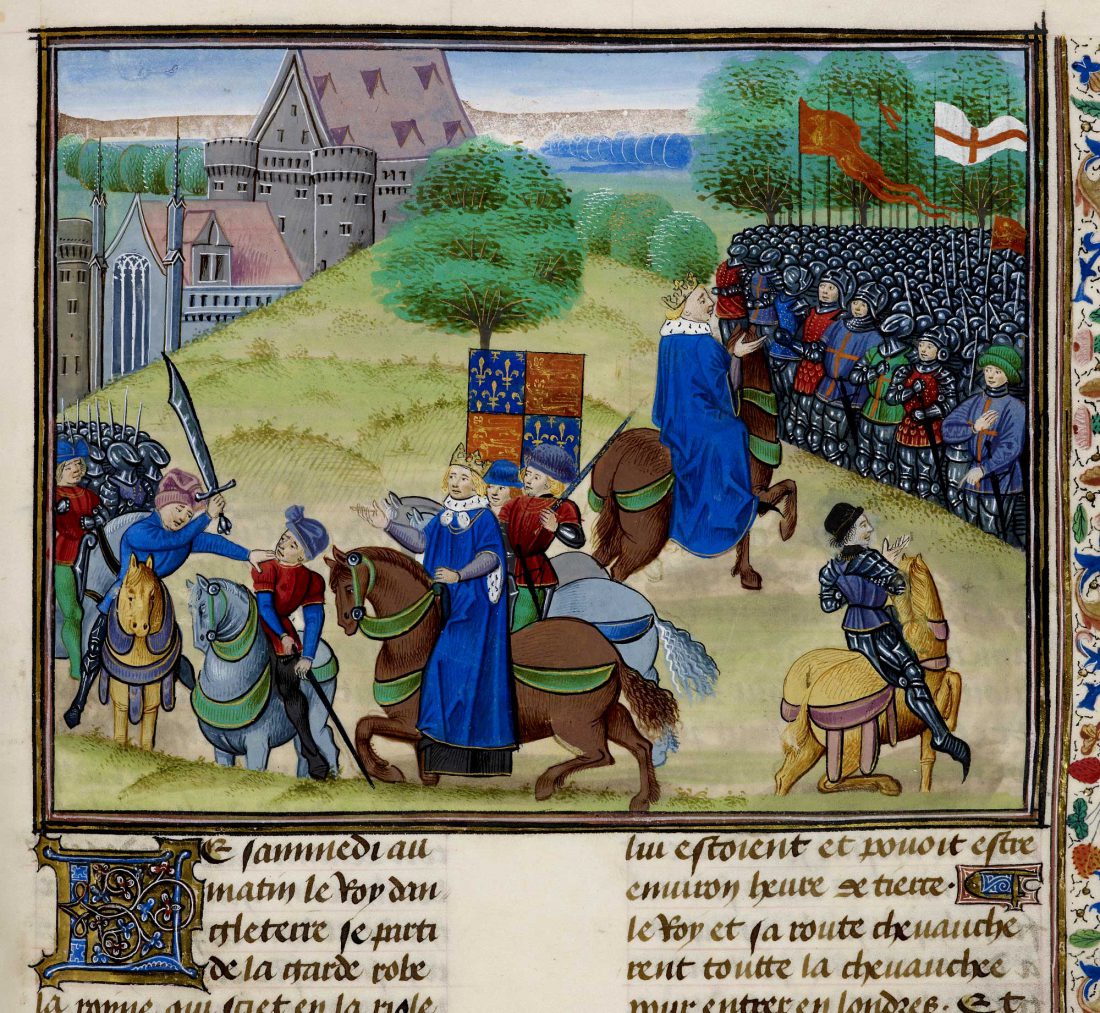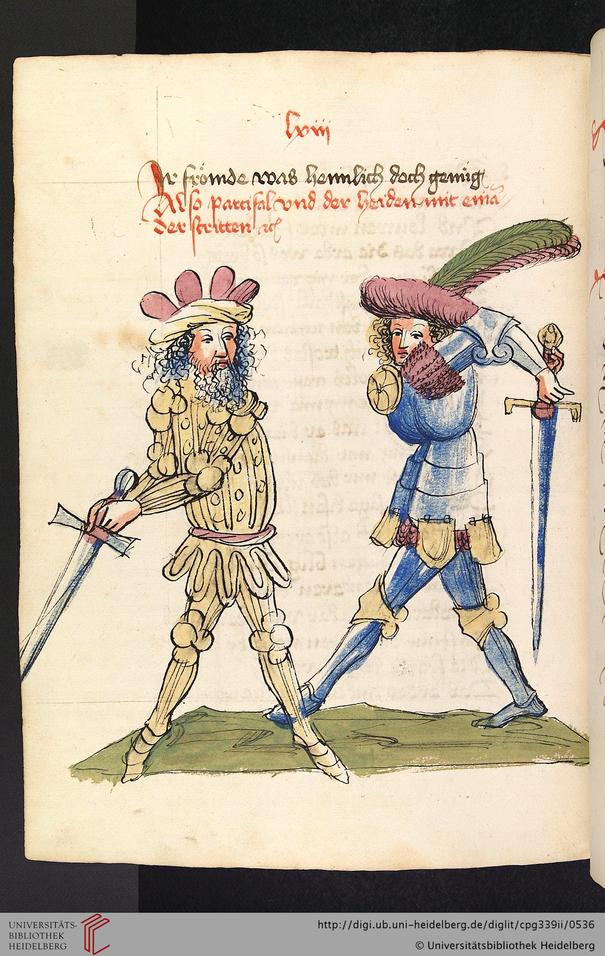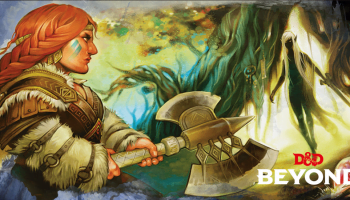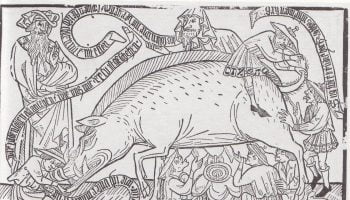This is Part VI of The Public Medievalist’s continuing series on Race, Racism and the Middle Ages.
Go back to the beginning of the series here.
Dr. Dark Age’s previous article in this series, A Brief History of a Terrible Idea: The “Dark Enlightenment”, briefly touched upon a tricky question: were medieval people racist?
For those familiar with some of the more horrible parts of the Middle Ages, such as the mass murders and expulsions of the Jews, the Crusades, or the wars in the Baltics, the answer might seem obvious: of course they were. And these well-known events corroborate a commonly held misconception about medieval people: that they were, at their core, worse people than we are. Heaping racism onto the other false idiocies and barbarities that are too-often part of today’s definition of the “medieval” is not that far of an intellectual leap. The Middle Ages are used, as Eric Weiskott put it, as “the negative mirror image of secularist modernity.”
But the truth is, as always, more complicated. As it turns out, medieval people’s ideas about what “race” actually means are quite different from our contemporary ideas about race. As I discussed last week, “race” is a concept that is entirely invented and socially constructed. Therefore it is unsurprising that medieval ideas about race could be fundamentally different to our own.
As an example of how complicated and strange medieval views on race could be, let’s focus on a text notorious for its complex and contradictory portrayal of race: the story of Percival. The two best-known medieval versions of the story are the 12th century French version, Perceval, the Story of the Grail by Chrétien de Troyes, and the 13th century German version, Parzival by Wolfram von Eschenbach. Both of these stories tackle regionalism, hybridity, and racial and religious conflict in surprisingly different ways, considering their subject matter is, at its core, the same. But first, a little background on race in the medieval mind.
The Chicken and Egg Problem of Medieval Racism
Until recently, medievalists were reluctant to use modern terms like “racism” to discuss medieval texts at all for a variety of reasons. First of all, the word “race” did not exist for the majority of the Middle Ages. As the OED explains, “race” was first used with this meaning in English in 1547 (just after the end of the Middle Ages) and similar words in French, Spanish and Portuguese only arose about hundred years prior.
Secondly, the words they did use, like the Latin “gens”, “natio”, and “populus” (all meaning, roughly, “people”) bore a few interesting quirks. As Robert Bartlett explains:
For the majority of medieval writers, ethnicity was defined by and manifested in culture as much as, or more than, descent. The classic and much quoted definition of Regino of Prum (d. 915) asserts that ‘the various nations differ in descent, customs, language, and law’ […] Of the four criteria listed here, only one is biological.
Bartlett unintentionally makes an important point: racial and racist stereotypes—even ostensibly positive ones (such as “Asians are good at math”)—by definition, conflate and confuse biology and culture. As discussed in Part IV of this series, this is the defining problem of race and racism—the misattribution of cultural observations (or vile prejudices) to biological realities.
But despite the similarities in the way these racial constructs conflate biology and culture, the categories the medieval West used to define other people were far more complicated, and far more flexible, than our own.
Medieval writers who used terms like “gens”, “natio”, and “populus” also conflated biology and culture far more finely than people who discuss “race” today. For example, Bartlett cites 14th-century Scottish chronicler John of Fordun, who saw the Scottish Highlanders and Lowlanders as two different “gens.” And in typical racist fashion, Fordun assigns attributes to each of them:
The race of the sea coasts is domesticated, civilized, faithful, patient, cultivated, decently dressed, refined and peaceable, devout in church worship, yet always ready to withstand any harm done by its enemies. The island or mountain race, however, is wild, untamed, primitive, intractable, inclined to plunder, leisure-loving, quick to learn, skilful, handsome in appearance but vilely dressed, and continually fiercely opposed to the English people and language, but also to their own nation, on account of the difference of language.
Even more interestingly, many medieval writers seemed to think that a race’s characteristics could change over time. This could happen by that group either relocating to a different place (since both skin color and other racial attributes were thought to be a byproduct of climate and location), or seemingly for no reason at all.
This flies in the face of contemporary racist ideas; contemporary racists base their claims on the idea that racial characteristics are both inherent and eternal—that groups are good or bad inherently because they always have been. Many medieval people seem not to have thought this way at all.
Blood is as Thick as Gold

Some medieval writers loaded their idea of race with aspects that today we might call intersectionality. For example, the medieval aristocratic class often viewed themselves as a breed apart from the people they ruled—believing they had more in common (due to shared bloodlines and status) with aristocrats in other kingdoms than the people of their own. This took on a shared identity, to which the nobility assigned traits that suited their purposes: knights were not only better warriors—inherently—than their peers, but they were also better looking. King Arthur is, of course, the best-known example of how a medieval man supposedly carried nobility, and with it special power, in his blood.
This is reflected in the Percival story. Percival was raised in the Welsh wilderness, but despite his humble upbringings, he is immediately recognized as one of their own by other knights. The reason is because he is just so very, very pretty:
The warriors eyed him closely. God’s skill lay in his creation, they saw […] no man’s appearance had ever turned out better since Adam’s time. Because of this his praise ranged far and wide in women’s mouths.
When he arrives at Arthur’s court for the first time,
They marked his complexion. That indeed was self-evident–never was lovelier fruit sired nor ladied. God was in a sweet mood for breeding when he wrought Parzival, who feared few terrors.
The knights of the court sometimes mock him for his backwardness, but they recognize him as one of their own by his skills in battle and his unparalleled beauty.
Descendants of this medieval idea of fine-grained race have been deployed in some of our most enduring popular culture, where special powers are passed through special families. The superpower-giving mutations of the X-Men are a classic example, which is why the comics and films often grapple allegorically with racial issues. The force-wielding power of Jedi Knights—midi-chlorian nonsense notwithstanding—is also passed within families. The question of Rey’s parentage that has consumed Star Wars fans since episode VII’s release has focused exclusively on Jedi. The Harry Potter series refreshingly breaks this paradigm, not just by introducing “muggle-born” wizards, but by framing one of its anti-racist narratives as pitting those who promote fine-grained bloodline racism versus those who are accepting of “muggle-born” and “half-blood” wizards.
Writing Racism
Racist discourses, where writers casually remark upon the positive or negative stereotypes of large groups of people—and where “race” and “culture” blend and are interchangeable—can be found commonly. But that is not to say that every medieval person, and that every medieval society, was uniformly racist; there is a silver lining to be found. In fact, it is relatively easy to find egalitarian portrayals of people of other races across medieval art and literature.
For example, the German version of the story, Parzifal, is broadly a reinterpretation of the story as it had been told by Chrétien, but interestingly, Wolfram’s German version includes a prequel that tells the story of Percival’s father, Gahmuret. Gahmuret was an adventurer-knight who, perhaps like Wolfram himself, had no particular issues with people of other races or faiths. On his adventures, he puts himself in the service of the king of Baghdad and fights alongside Saracens. He then travels to a legendary kingdom in Africa, where he marries its queen, Belcane. Together they have a son—Percival’s half-brother, Feirefiz—who is Percival’s equal in all aspects of knighthood—as a warrior, as a wealthy man, and as a lover. Wolfram writes:
He became a wood-waster—the jousts of his hands shattered many a spear, riddling shields with holes.
And Feirefiz was no aberration. One could also point to the other literal black knights in the Arthurian canon—not one “token”, but a cadre of four: Sir Morien, Sir Palamedes, Sir Safir, and Sir Segwarides. Or one could point to various positive depictions of Africans in medieval art, as catalogued on the popular Tumblr page People of Color in European Art History, or explored in the crucial book on the topic The Image of the Black in Western Art, Part II.
Race and Faith
It’s almost impossible to talk about medieval race without talking about religion. Today faith is often considered a category separate from race. This is a byproduct of the evangelical natures of Islam and Christianity, where the faithful are exhorted to convert those outside their community. Judaism is often cited as one of only a few modern-day counterexamples, where lineage and religion are more closely tied (though in no way exclusively, since there exists a long tradition of conversion to Judaism as well). However these notions of community, lineage, and religion were more closely bound together in the Middle Ages, as Bartlett explains:
Especially in a period like the Middle Ages, when religion meant membership of a community much more than adherence to a set of principles or beliefs, there was a sense in which one was born a Christian, a Muslim, or a Jew, just as one was born English or Persian.
This is evident in the curious condition of Feirefiz’s skin, which is mottled black and white:
The lady gave birth to a son, who was of two colors. By him God devised a miracle—both black and white was his appearance. The queen kissed him incessantly, very often on his white marks. […] his hair and his entire skin became, in hue, like that of a magpie.

Setting aside the abysmal medieval understanding of genetics—obviously biracial children do not have mottled skin (barring those with vitiligo)—the queen is partial to his white spots not because she prefers whiteness for the sake of whiteness, but because those represent Feirefiz’s father, and possibly, his father’s Christianity. And moreover, Wolfram characterizes his skin not in negative terms, but as one of God’s miracles.
Fascinatingly—and something that will be discussed in more depth in a later article in this series—in medieval literature there are even instances where a character’s skin changes with his conversion. Feirefiz, however, is not one of these characters.
Ultimately, Feirefiz decides to convert to Christianity. When he does, he immediately gains the ability to see the Holy Grail—something only Percival had been able to do. His life trajectory parallels Percival’s in many ways, each rising from the disadvantages of an absent father to find fame and glory through their heroism.
Looking to the Authors
Characters never exist in a vacuum. The characters of the X-Men, of Star Wars, and of Harry Potter tell us something about how their authors see the world. Similarly, Feirefiz, Percival, and Gahmuret reveal something about the author of Parzifal, Wolfram. Despite, seemingly, every opportunity to cast aspersions on people from Africa or the Middle East, Wolfram never does. Gahmuret pledges himself to the king of Baghdad because he is a good and generous overlord, plain and simple. Gahmuret falls in love with Belacane and her skin color is immaterial. Feirefiz’s skin is a curiosity, to be sure, but no impediment in any way. And, on several occasions, Wolfram states explicitly that those with black skin are no less able in everything that mattered to him (beauty, wealth, and prowess) than people with white skin.
But of course, not all medieval people were so unbiased. To find one, we need only look at the French version of Percival. This earlier version does not contain the Feirefiz subplot or the Gahmuret prequel story. Worse, its author Chrétien de Troyes injects vastly anti-Semitic language into his story, for example in a passing mention of Jesus’ Crucifixion:
This death was holy, for our Lord / both saved the living and restored / the dead from death to life again. / The traitor Jews, who should be slain / like dogs, established in their hate / our great good and their wretched state, / for when they raised Him on a cross, / they saved us and ensured their loss.
Blaming Jews for the death of Christ is among the oldest anti-Semitic slanders in the book. And interestingly—likely tellingly—despite the fact that Wolfram copied a significant amount from the earlier work by Chrétien, his anti-Semitism does not seem to have been transferred.
So that brings us squarely back to the initial question: “were medieval people racist?” Some medieval people definitely were. Even though their idea of what constitutes a “race” differed fundamentally, and they deployed different words to describe it, the fact remains that they did bear prejudiced ideas based upon superficial physical differences. But, like people today, many medieval people were not. People like Wolfram valued cosmopolitanism and multiculturalism, and showed ample respect for those different to them. And that basic respect was necessary for trade, and for learning, to exist. As Dr. DarkAge put it,
Al-Andalus, aka Muslim Spain, was right next to France. Parts of France were also England, and vice versa. The Vikings landed in all those places. Western European culture relied heavily on philosophical, literary, commercial, and scientific exchanges with people who were not white.
To this list of more-cosmopolitan and multicultural societies, one can add Norman Sicily, the Byzantine Empire, the Vikings (who seemed ever-eager to adapt to and adopt new cultures), and others that we will explore as this series continues.
The easiest possible answer to the question is this: Medieval people were likely not significantly more racist than we are today (if such a thing could even be quantified). In both times, if you look to find racism, both personal, institutional, and structural, it can be readily found. And in both times, you can find those who reject it. What we can say is that medieval racism was very different. This should not offer us any comfort; nothing gives modern-day racism a pass. Racism is a problem that plagues most periods and cultures in humanity, but the most successful, innovative and just societies are those that can most effectively conquer it.
Continue to Part VII in our series: “Where Were the Middle Ages?“
The Public Medievalist does not pay to promote these articles, so we would love it if you shared this with your history-loving friends! Click to share with your friends on Facebook, or Twitter.





I enjoyed the article, and agree – but I think a key element of mediaeval man’s world-view was that there was no such concept as equality. Society was intricately structured as a bewildering hierarchy that culminated, at its top, in the two highest exponents of mankind on earth, the Pope and the Emperor. The whole point of mediaeval life was to improve on one’s position in the hierarchy.
In that hierarchy, the individual was secondary – the individual was just the warm body that happened to occupy that slot in the hierarchy, and he or she was identified by the slot he or she filled, not vice versa.
Under that aspect, it becomes more understandable why race, in our modern conception, simply did not matter to mediaeval man.
A very instructive (and I am saying this as a reluctant convert) field is mediaeval gender studies, which drive home the realisation that gender and biological sex have precious little to do with each other. So it also is with race.
Religion is slightly different, given its constitutional importance. But there, too, the records we have on trade paint a completely different picture from that emanating from the obedient Christian clerics who wrote most of the extant documentation.